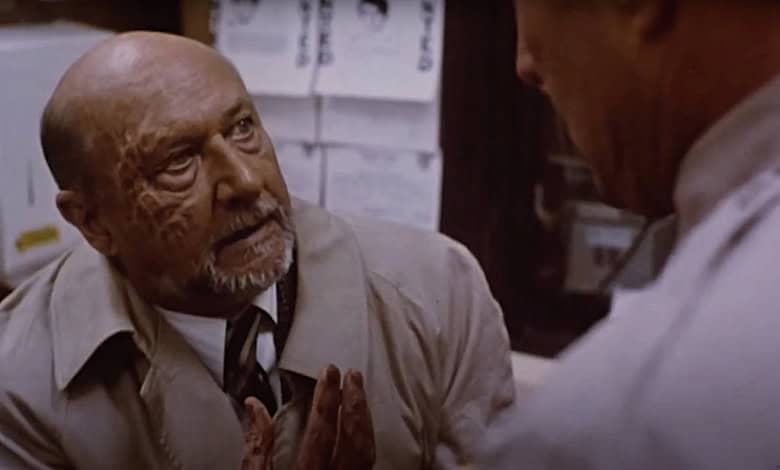Dominique Othenin-Girard’s “Halloween 5: The Revenge of Michael Myers” (1989) immediately grabs us with an opening title sequence riffing on the “pumpkin carving reveal” of prior installments.
It also establishes its most distinct quality. It’s willing to take chances. Not all of them will work, let alone make sense.
We briskly revisit the climax of the prior film, where the masked and seemingly unstoppable serial killer (Don Shanks) is relentlessly pursuing his niece, Jamie (the remarkable Danielle Harris) and her babysitter Rachel (Ellie Cornell).
A car crash, in which Myers is thrown from a vehicle, leads to an odd police shootout and Myers falling down a mine shaft. From there, the movie makes some strange choices, and it doesn’t end there.
Following the “Previously on Halloween” flashback, we watch as the wounded Myers goes into hiding. It’s always interesting to watch Myers outside of the stalk n’ slash story confines.
Jamie now has a clearly defined psychic link between her and Myers, and she hasn’t spoken since Myers’ prior attack on her life. Much worse? The film briefly references the devastating final scene from “Halloween 4,” then discards it, seemingly telling us to just forget about it.
What?! Can you imagine a sequel to “The Sixth Sense” that begins with the reveal that the final twist was just a dream?!
“Halloween 5” survives this early misstep but really, if the filmmakers were unwilling to follow up on the giant whammy the last movie left us in its final reveal, they should have avoided following Jamie as a character.
Thankfully, Harris is so good in this (as she was in the prior installment), that the movie leapfrogs over a bad first-act creative decision.
RELATED: ‘HALLOWEEN 4’ REVIVED SLEEPY SAGA
Othenin-Girard is clearly a demonstratively stylish filmmaker, though not all of his touches work. The weird inclusion of the supernatural (mentioned in “Halloween II” and overtly portrayed in the wild “Halloween III: Season of the Witch”), some extensive world building (more on that in a bit) and some daring and not always successful creative choices make this one of the most interesting, if not entirely successful, of the “Halloween” sequels.
Shanks is a very good Myers, who sports the thorn tattoo that becomes a major storyline of the equally interesting, often baffling “Halloween 6: The Curse of Michael Myers” (1995). The latter is far more satisfying and battier in its extended, preferred Producer’s Cut.
Myers’ face can be clearly seen from the distance in one shot, in a great, surprising moment where he faces Jamie. There’s also a knockout bit when Jamie falls down a laundry chute, which we see from her perspective. It’s a breathtaking shot.
“Halloween 5” is lively but unpleasant, devoid of heart (they really needed to keep Cornell’s welcome presence in the movie), as well as lacking the hometown feel of the original. Haddonfield is misshapen, clearly a series of locations, sets and odd spots, whereas Carpenter’s original and the earlier sequels made it seem vivid and real.
With or without dialogue, Harris is still excellent in this and acts her heart out. Pleasance’s big acting choices are exactly right – Loomis desperately wants Myers to stop killing but he mostly succeeds in burning bridges with everyone he meets. You could make a comedy out of how Loomis might be the most obnoxious, unlikable and hilariously unhinged “hero” of any movie.
Halloween 5: The Revenge of Michael Myers.
Any fans? pic.twitter.com/Z8j99BBXxL
— Michael Myers (@MichaelMyersIM) October 30, 2024
Both ambitious and underwhelming, this rushed sequel sports plot twists both promising and ill considered. When it goes through the motions, it drags. Placing two small, sweet, screaming children in peril for most of the movie (they’re even chased by a car while they scamper on foot) is a dubious touch, even for this franchise.
The third act is on stalk n’ slash autopilot, except for two scenes: Jamie’s aforementioned escape down a laundry (seriously, that POV shot is amazing and must have been a nightmare to set up) and the final, apocalyptic closing scene.
The cliffhanger finale would take too long to finally resolve, a major reason why the most daring touches in “Halloween 5” didn’t pay off – imagine finding out the final episode of “Lost” and its biggest secrets…this year.
There’s also the unseen Man in Black, with steel-toed shoes and matching Thorn tattoos, is such an intriguing, welcome and strange touch. It’s a shame that the mystery of this character was belatedly resolved, finally, six years later, when “Halloween: The Curse of Michael Myers” unveiled the secret in a manner resembling busy work instead of a proper Tah-Dah!
Alan Howarth’s electronic score makes some bad calls – most notoriously providing wacky sound effects whenever we get an appearance from two Mutt n’ Jeff cops. Why the music choice and what are those characters even doing in this movie?
Part 5 isn’t anywhere near as bad as “Halloween: Resurrection” (2002) or the worst parts in the past two Blumhouse Halloween sequels. The franchise was on seriously shaky ground at this point, not gaining proper momentum and a series high of “Halloween: H20” in 1998.
Halloween 5: The Revenge of Michael Myers (1989).
Art by Aaron Fulcher. pic.twitter.com/71wBtxz4ti— The Retro Reminiscer (@RetroReminiscer) October 23, 2024
“Halloween 5” was a turning point and impresses for taking some wild swings but was also a step down from the Hitchcockian touches of “Halloween 4.”
The filmmakers probably should have waited longer after the success of “Halloween 4” to properly plan and map out this sequel, rather than rush it into theaters with it feeling like an unfinished and quirky cash-in.
If nothing else, “Halloween 5” sports the core problem that plagued subsequent sequels: the premise is best kept simple. John Carpenter knew not to pile on too many subplots or lean into the overtly supernatural…or give us wacky sound effects.
“Halloween 5” wound up underperforming at the box office and not initially impressing longtime fans, hurting the momentum gained by the prior installment. It wouldn’t be the last time the series had to take a hiatus, before coming back strong years later, sporting a new direction.
The finest of these later episodes, “Halloween: H20” (1998) and “Halloween” (2019) discarded the tonal and narrative miscues, though the follow-up sequels piled them on again. Clearly, it was the screenplays, and not a plump pumpkin, that needed some additional craving on Halloween.






